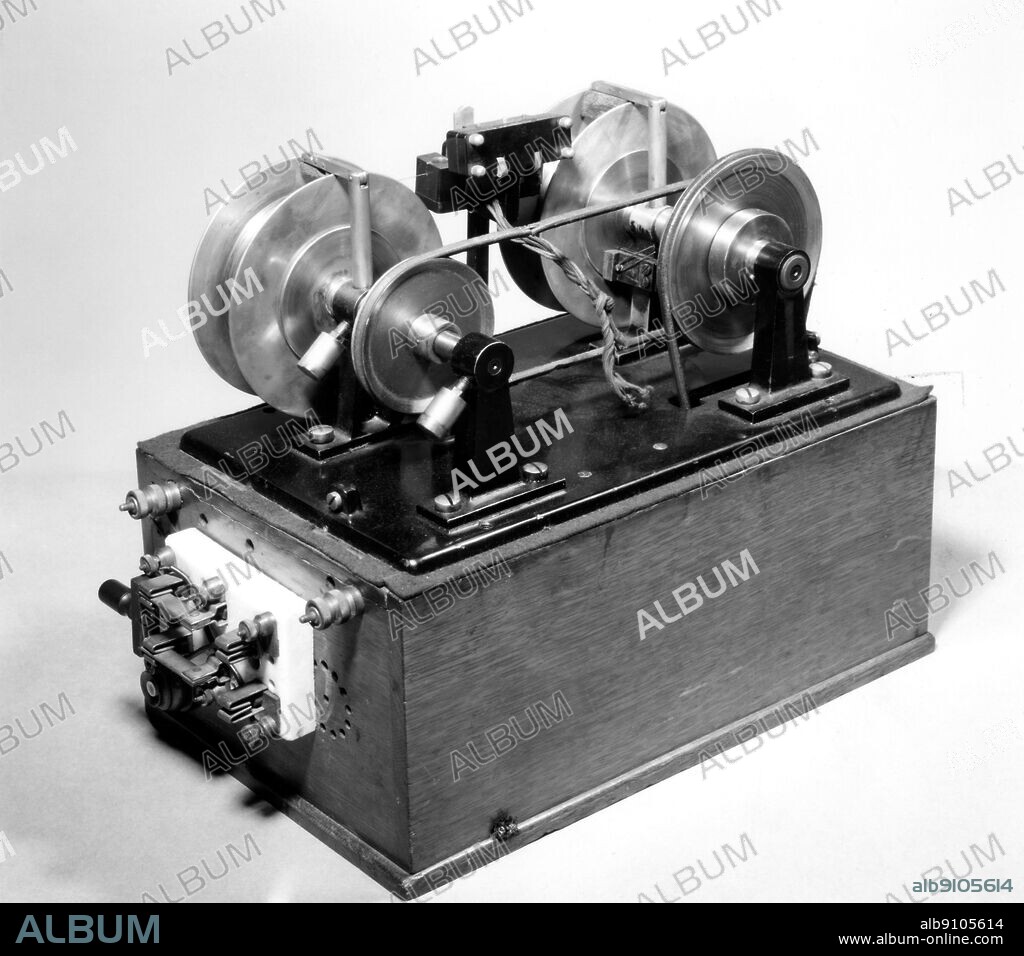alb9105614
Telegraphone - The audio tape recorder was invented just a few years after the phonograph, but most people would never hear about it until the 1950s. In the late 1870s, an engineer from New Jersey named Oberlin Smith came up with the idea of a 'magnetic' recorder after seeing Edisons work on the phonograph and the telephone. By using a telephone, an electromagnet, and a long piece of wire, he was able to capture sound as a region of varying magnetism rather than as a wavy groove. Smith never demonstrated the recorder, but in the early 1890s the Danish inventor Valdemar Poulsen either read about it or reinvented it himself. Poulsen patented the recorder, which he called the 'telegraphone' in 1899 and tried to sell the rights in various countries to manufacture it. In the United States, the rights were purchased in 1903 by a group of investors. They established the American Telegraphone Company of Washington, D.C. A factory was set up in Wheeling, West Virginia, but it was later moved to Springfield, Connecticut. . American Telegraphone sold telegraphones for use as scientific instruments, telephone answering machines, and office dictating systems. While several hundred were sold to curious scientists, only one or two were actually used for telephone or dictation recording. After a few years, American Telegraphone closed its doors, and the magnetic recorder was not heard from in the United States for many years. . ©TopFoto

|
Zu einem anderen Lightbox hinzufügen |
|
Zu einem anderen Lightbox hinzufügen |



Haben Sie bereits ein Konto? Anmelden
Sie haben kein Konto? Registrieren
Dieses Bild kaufen.
Nutzung auswählen:

Titel:
Telegraphone - The audio tape recorder was invented just a few years after the phonograph, but most people would never hear about it until the 1950s. In the late 1870s, an engineer from New Jersey named Oberlin Smith came up with the idea of a 'magnetic' recorder after seeing Edisons work on the phonograph and the telephone. By using a telephone, an electromagnet, and a long piece of wire, he was able to capture sound as a region of varying magnetism rather than as a wavy groove. Smith never demonstrated the recorder, but in the early 1890s the Danish inventor Valdemar Poulsen either read about it or reinvented it himself. Poulsen patented the recorder, which he called the 'telegraphone' in 1899 and tried to sell the rights in various countries to manufacture it. In the United States, the rights were purchased in 1903 by a group of investors. They established the American Telegraphone Company of Washington, D.C. A factory was set up in Wheeling, West Virginia, but it was later moved to Springfield, Connecticut. . American Telegraphone sold telegraphones for use as scientific instruments, telephone answering machines, and office dictating systems. While several hundred were sold to curious scientists, only one or two were actually used for telephone or dictation recording. After a few years, American Telegraphone closed its doors, and the magnetic recorder was not heard from in the United States for many years. . ©TopFoto
Untertitel:
Siehe automatische Übersetzung
Telegraphone - The audio tape recorder was invented just a few years after the phonograph, but most people would never hear about it until the 1950s. In the late 1870s, an engineer from New Jersey named Oberlin Smith came up with the idea of a 'magnetic' recorder after seeing Edisons work on the phonograph and the telephone. By using a telephone, an electromagnet, and a long piece of wire, he was able to capture sound as a region of varying magnetism rather than as a wavy groove. Smith never demonstrated the recorder, but in the early 1890s the Danish inventor Valdemar Poulsen either read about it or reinvented it himself. Poulsen patented the recorder, which he called the 'telegraphone' in 1899 and tried to sell the rights in various countries to manufacture it. In the United States, the rights were purchased in 1903 by a group of investors. They established the American Telegraphone Company of Washington, D.C. A factory was set up in Wheeling, West Virginia, but it was later moved to Springfield, Connecticut. American Telegraphone sold telegraphones for use as scientific instruments, telephone answering machines, and office dictating systems. While several hundred were sold to curious scientists, only one or two were actually used for telephone or dictation recording. After a few years, American Telegraphone closed its doors, and the magnetic recorder was not heard from in the United States for many years. ©TopFoto
Bildnachweis:
Album / TopFoto
Freigaben (Releases):
Model: Nein - Eigentum: Nein
Rechtefragen?
Rechtefragen?
Bildgröße:
3923 x 3461 px | 38.8 MB
Druckgröße:
33.2 x 29.3 cm | 13.1 x 11.5 in (300 dpi)
Schlüsselwörter:
 Pinterest
Pinterest Twitter
Twitter Facebook
Facebook Link kopieren
Link kopieren Email
Email
